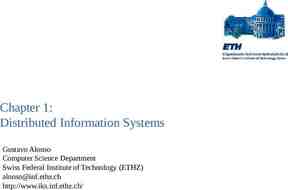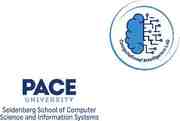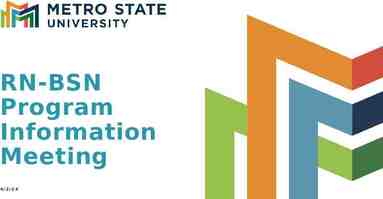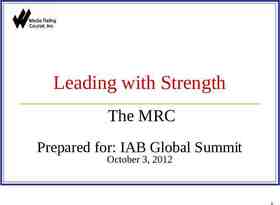MAY 2018 ICAO TRIP Guide on BCM 1
50 Slides6.94 MB

MAY 2018 ICAO TRIP Guide on BCM 1

Structure of the Presentation 6 Elements: i. Introduction (slides 2 to 7) ii.Guide Concepts (slides 8 to 12) iii.Strategy and Environment (slides 13 to 19) iv.TRIP Implementation – Inspection Systems and Tools, Interoperable Applications and Traveller Journey (slides 20 to 40) v.TRIP Implementation – Risks and Constraints (slides 41 to 47) ICAO TRIP Guide Contacts on BCM vi.Conclusion – Assistance to States and ICAO (slides 48 to 50) 2

i. INTRODUCTION Scope of the Guide Contributors How to use the Guide TRIP and BCM ICAO TRIP Guide on BCM 3

Scope of the Guide Why? Challenging global environment – Increase in international air travel – Constrained airport infrastructure – Evolving security threats Framework: Annex 9 – Facilitation, ICAO TRIP Strategy, Doc 9303, UN treaties and UN Security Council Resolutions Area: Air travel environment, border controls applied to travellers Application: Best practice for use of technology and beyond ICAO TRIP Guide on BCM 4

Contributors ICAO TRIP Guide on BCM 5

How to use the Guide Part 1: Guidance Part 2: Assessment Tool Download at: https://www.icao.int/Security/FAL/TRIP (along with other TRIP publications) ICAO TRIP Guide on BCM 6

ICAO TRIP and BCM ICAO TRIP Guide on BCM 7

ii. GUIDE CONCEPTS Linking Inspection Systems and Tools and Interoperable Applications Border Control Systems The “Snowman” – the unifying concept of the Guide Phases of the Traveller Journey ICAO TRIP Guide on BCM 8

Inspection Systems and Tools and Interoperable Applications ICAO TRIP Guide on BCM 9

Border Control Systems (BCS) ICAO TRIP Guide on BCM 10

Unifying Concept of the Guide The Identification of travellers informs, and is informed by, traveller risk assessment. – An iterative process undertaken throughout the phases of the traveller journey as additional and updated information becomes available about travellers. ICAO TRIP Guide on BCM 11

Phases of the Traveller Journey The traveller journey is illustrated taking the perspective of the receiving State. ICAO TRIP Guide on BCM 12

iii. STATEGY AND ENVIRONMENT BCM Environment Frameworks National and Regional Collaboration Including National Air Transport Facilitation Programme (NATFP) International Law Maturity Map ICAO TRIP Guide on BCM 13

BCM Environment Travel patterns are influence by environmental factors: – e.g. geography, history, economic development, societal factors and conflict. BCM is a national response to the each State’s environment – to maximise the benefits of travel while mitigating threat and risk. ICAO TRIP Guide on BCM 14

Frameworks BCM is a regulatory function operating within a State’s policy, legislative and procedural frameworks National implementation of TRIP must : –Contribute to achieving policy objectives; –Be authorised by legislation; and –Support standard operating procedures. ICAO TRIP Guide on BCM 15

National and Regional Collaboration Success in BCM requires contributions from: Mutual understanding of roles and processes builds respect and trust as the foundation for effective communication, co-ordination and collaboration. ICAO TRIP Guide on BCM 16

National Air Transport Facilitation Programme (NATFP) Purpose: Means of coordinating activities between national departments or agencies concerned with or responsible for various aspects of facilitation of national civil aviation Improve the effectiveness and efficiency of clearance control formalities Operationalization through national FAL committees NATFP and National Civil Aviation Security Programme are complementary Establishing a NATFP is an ICAO Standard

International Law Major UN treaties with direct relevance to BCM : UNSCR including BCM related measures : 1944 Convention on International Civil Aviation (ICAO) 1951 United Nations Convention Relating to the Status of Refugees and its 1967 Protoco (UNHCR) 1954 United Nations Convention relating to the Status of Stateless Persons (UNHCR) 2000 United Nations Convention against Transnational Organized Crime and its 2000 Protocols (UNODC) 1948 Universal Declaration of Human Rights and the core international human rights instruments (OHCHR) UNSCR 1373 (2001) on threats to international peace and security caused by terrorist acts UNSCRs 1267 (1999), 1989 (2011) and 2253 (2015) includes the Consolidated United Nations Security Council Sanctions List (CUNSCSL) UNSCR 2178 (2014) includes API UNSCR 2309 (2016) includes implementing ICAO Annex 9 SARPS UNSCRs 2322 (2016) and 2396 (2017) includes sharing biographic and biometric information about FTFs and other terrorists UNSCR 2396 (2017) includes API and PNR. ICAO TRIP Guide on BCM 18

Maturity Map The essential foundation of a national BCS is a: an inspection system; with integrated MRTD readers More complexity should be added only when budget is available and border agency capability is developed enough to achieve and sustain change. ICAO TRIP Guide on BCM 19

iv. TRIP IMPLEMENTATION Inspection Systems and Tools; and Interoperable Applications ICAO TRIP Guide on BCM 20

Inspection Systems and Tools, Interoperable Applications and the traveller journey Systems, Tools and Applications applied across the phases of the traveller journey Systems, Tools and Applications applied at specific phases of the traveller journey ICAO TRIP Guide on BCM 21

Across the phases of the traveller journey Some contribute primarily to identification of travellers: Document Readers Biographic Identity Verification Biometric Identity Verification PKI and PKD eMRTD Biometric Identity Verification Others contribute primarily to traveller risk assessment: National Watchlists International Watchlists INTERPOL SLTD Database ICAO TRIP Guide on BCM 22

Document Readers MRTD and eMRTD document readers are the fundamental tool for leveraging the interoperability of MRTDs ICAO TRIP Guide on BCM The technical specifications of Doc 9303 deal exhaustively with the interoperable features required of document readers. 23

Biographic Identity Verification Integration of national passport and other national identity data into a State’s BCS can provide a basis for identity verification of citizens and residents. ICAO TRIP Guide on BCM 24

PKI and the ICAO PKD States upload PKI certificates of the eMRTDs they issue to facilitate the travel of their national document holders to other States. States download the PKI certificates of eMRTDs issued by other States to authenticate the eMRTDs of travellers to their own State before they commence their journey at visa issuance, at entry and at exit. ICAO TRIP Guide on BCM ICAO Recommended Practice is for States issuing eMRTDs to join the PKD and upload their information to it. 25

eMRTD Biometric Identity Verification Subject to PKI authentication of the eMRTD, biometric images read from the eMRTD can be relied to verify identity by comparison of images taken of the same biometric feature of the traveller. eMRTD biometric identity verification can be undertaken at different phases of the traveller journey, whenever the eMRTD is presented by the traveller. ICAO TRIP Guide on BCM ICAO Recommended Practice is for States to join the PKD and use the information available from the PKD to validate eMRTDs at border controls 26

Biometric Identity Verification Biometric identity verification is achieved by comparing an image of the traveller with a reference image. The reference image can be enrolled prior to the traveller journey, for instance: At visa or ETS issuance; As part of a registered traveller programme; or Obtained from a national database of passport or ID card. Effective biometric identity verification solutions have security and process efficiency benefits and can be used at every stage of the traveller journey. ICAO TRIP Guide on BCM 27

National Watchlists A national watchlist can include as targets the identity attributes of travellers known to represent a risk or threat to a State. Advanced search functionality can improve watchlist matching. Data analysis (e.g. combining travel and visa history, API, PNR and other data sources) can be used to develop temporary risk based interventions targeting specific flights or travellers. ICAO TRIP Guide on BCM 28

INTERPOL SLTD Checks against the INTERPOL SLTD provide assurance that travel documents remain in the hands of the traveller to whom they were issued. INTERPOL SLTD checks require integration with the Border Control Systems of the State; and Support at secondary examination to resolve referrals ICAO TRIP Guide on BCM ICAO Recommended Practice is for States to query the MRTDs of travellers against the INTERPOL SLTD 29

International Watchlists To meet their obligations to combat transnational crime, including terrorism, States should integrate checks of INTERPOL nominal data and checks of the Consolidated United Nations Security Council Sanctions List (CUNSCSL) into their national BCS. ICAO TRIP Guide on BCM UNSCR 2396 (2017) calls on States to implement biometric (& biographic) watchlists to identify terrorists 30

Pre-Departure Phase Visa & ETS Biometric Enrolment for Registered Traveller Programme PNR ICAO TRIP Guide on BCM 31

Visa & ETS Enables risk assessment of travellers before travel commences. ETS have facilitation benefits over traditional visas, because they are typically quickly and conveniently obtained online. ICAO TRIP Guide on BCM ICAO Recommended Practice includes guidance on ETS design 32

Passenger Name Record Airline PNR is a rich source of additional data about traveller but PNR data is sensitive and must be adequately protected and PNR data can only be successfully applied by users with sophisticated investigation and intelligence capability able to use data analysis tools. ICAO TRIP Guide on BCM UNSCR 2396 (2017) calls on States to implement PNR 33

Pre-Arrival Phase iAPI & API Liaison Officers ICAO TRIP Guide on BCM 34

API and iAPI Receiving travel document and flight information relating to arriving or departing travellers: Gives border control agencies additional time to complete traveller identification and risk assessment; Facilitates pre-clearance; and In the case of iAPI, can prevent travel commencing by returning a message to airline check-in to refuse boarding. ICAO TRIP Guide on BCM GUIDELINES ON ADVANCE PASSENGER INFORMATION (API) 2013 UNSCR 2178 (2014) and UNSCR 2396 (2017), amongst others, calls on States to implement API. 35

Liaison Officers Liaison Officers are typically deployed: By States at risk of receiving large numbers of inadmissible passengers; At the major embarkation and transit airports of travel to the deploying/receiving State; With the agreement of the border authorities at the airports where they operate; To work with airlines to identify and prevent the onward travel of inadmissible passengers. ICAO TRIP Guide on BCM ICAO Recommended Practice is to permit liaison officers at airports to assist airlines in travel document examination 36

Entry, Stay & Exit Phases Entry & Exit Databases Managing Stay (residence permits & visa extensions) Exit Database Automated Border Controls ICAO TRIP Guide on BCM 37

Entry and Exit Databases A database of the “entry” of all travellers is a foundation for longitudinal analysis The addition of an “exit” database provides a basis for reconciliation to determine patterns of “stay” For both “entry” and “exit” databases: Reporting of aggregated data reveals patterns and growth e.g. for Tourism policy planning Data on individual travellers informs risk identification and analysis ICAO TRIP Guide on BCM 38

Automated Border Controls Enhances efficiency in traveller processing and identity verification, and enables redeployment of border personnel for targeted interventions to achieve facilitation and security objectives. ICAO TRIP Guide on BCM ICAO Recommended Practice is for States to consider the introduction of ABC, integrated with integral PKD and INTERPOL SLTD checks, to facilitate air travel 39

Managing Stay For States, the ultimate purpose of BCM is to regulate the outcome of the travel process – the “stay” of travellers in the State. ICAO TRIP Guide on BCM In advanced BCS, traveller information is used to regulate and determine: Who is present in the State; How long they are permitted to remain; and What conditions are attached to their continued stay? 40

v. TRIP IMPLEMENTATION Risks and Constraints ICAO TRIP Guide on BCM 41

Implementation of TRIP in BCM– Risks & Constraints Five risks to avoid or mitigate for the successful application of TRIP in BCM: 1. Organisational Capability 2. Primary and Secondary Examination 3. Transparency and Governance 4. Manual and Visual Inspection of Travel Documents 5. BCM Strategy ICAO TRIP Guide on BCM 42

Risk #1 Organisational Capability Complex The implementation of advanced TRIP Tools and Interoperable Applications is highly contingent on: Basic inspection systems being in place; and Deep capability to understand and evaluate options for change Foundation ICAO TRIP Guide on BCM 43

Risk #2 Primary and Secondary Examination ICAO TRIP Guide on BCM 44

Risk #3 Transparency and Governance The risk of corruption in BCM needs to be assessed and mitigated by States so that their investments in TRIP implementation can be successful. ICAO TRIP Guide on BCM 45

Risk #4 Manual & Visual Inspection of Travel Documents ICAO TRIP Guide on BCM 46

Risk #5 BCM Strategy 1. 2. About this Guide – Scope and Application ICAO TRIP and Border Control Management 3. National Strategies for Border Control Management Foundation TRIP Implementation 4. National Border Inspections Systems and Tools 5. Interoperable Applications ICAO TRIP Guide on BCM 47

vi. CONCLUSION Assistance to States ICAO Contact Information ICAO TRIP Guide on BCM 48

Assistance to States ICAO hosts events; develops and publishes SARPs, technical specifications and guidance material; and works with partners to provide technical assistance supporting TRIP implementation ICAO TRIP Guide on BCM 49

Security & Facilitation International Civil Aviation Organization 999 Robert-Bourassa Boulevard Montréal, QC, Canada H3C 5H7 Email: [email protected] Tel: 1 514 954-9219 Fax: 1 514 954-6077 www.icao.int/Security/FAL/TRIP ICAO TRIP Guide on BCM 50






